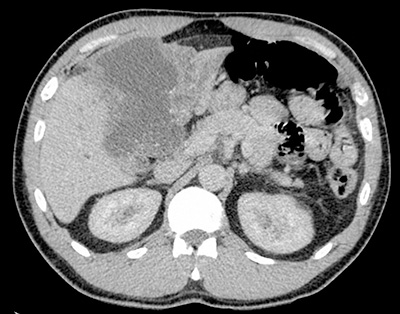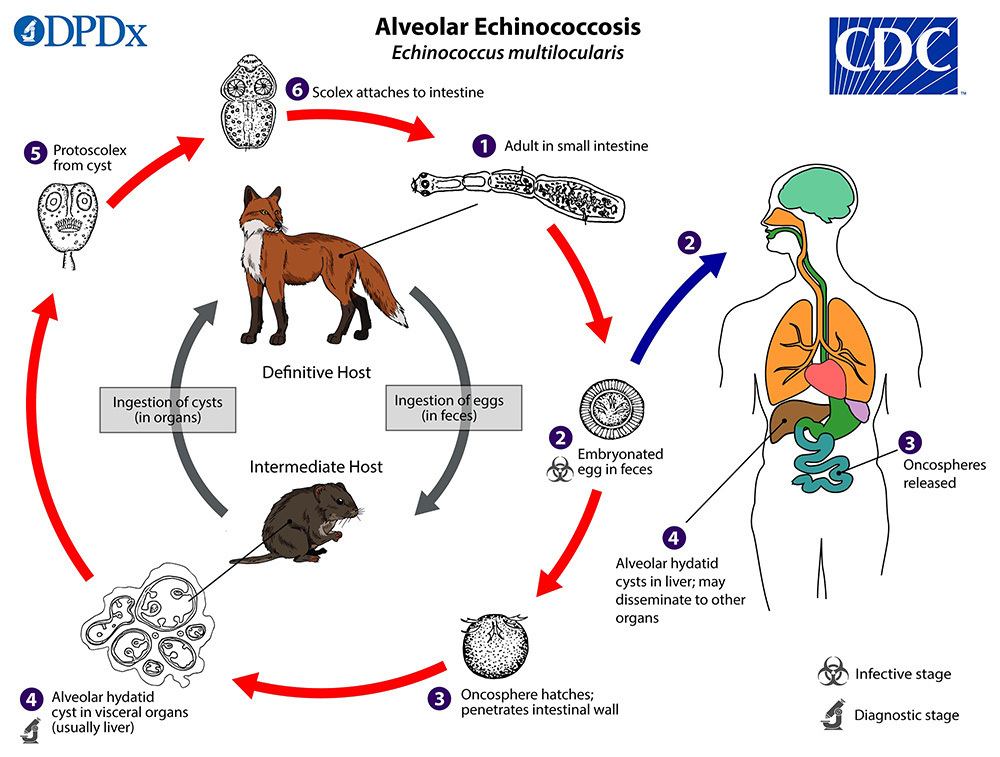
After living through the COVID years and watching The Last Of Us, we’ve seen how infections can spread among those who don’t take precautions. Well, here is the latest unexpected but preventable condition hitting Albertans.
Does this sound like you?
- You love dogs and have a dog or two (or three).
- You live in an area that has urban or rural foxes or coyotes.
- Your dog runs around off-leash parks in a city or town or in rural areas that foxes and coyotes visit.
- You let your dog lick your face.
If any of these apply to you, then heads up, a new alien invader is in Alberta, ready to make a warm little home in your liver or brain – Yikes!
Alberta has become a hotspot for a potentially deadly tapeworm called Echinococcus multilocularis.
This parasite is passed from wild canines like coyotes, foxes, and even domestic dogs to humans.
Dogs aren’t the only transmission source. You can also get infected from snacking on unwashed goodies like lettuce, strawberries or other produce from your rural garden.
Medical experts are raising alarms as many cases of this parasite infection are likely undetected.
What is this Tapeworm, and Why is it in My Liver?
Echinococcus multilocularis is a tiny intestinal tapeworm that causes a disease known as alveolar echinococcosis (AE).


The tapeworm, native to Europe, was first detected in wildlife in Western Canada in 2012.
One year later, the first human case of AE was found in a woman in rural Alberta.
This disease is severe and can be fatal if not treated.
Since the first case in 2013, the number of AE cases has been rising, especially in Alberta, where at least 30 people have been diagnosed with the disease, with most cases happening since 2020.
You would be wrong if you imagined your intestines full of wiggling worms. The larval stage of the tapeworm, not the adult worms, causes problems in humans.
The larva migrates to your organs, favouring livers, but can get into your lungs, heart and brain and once settled there, dangerous lesions develop.
So, How Do People Get Infected?
People can get infected by ingesting food or soil contaminated with tapeworm eggs too small to see. Hence, washing your garden veggies or your wild-harvested berries is super important.
Your furry best friend can pick up a few tapeworm eggs by sniffing fox or coyote poop. Guess what might happen when Fido licks your face while you’re on the couch watching TV?
Once in your system, the eggs develop into the pesky larva, which likes to make its new home in your organs. The larva develops slowly over five to 15 years, causing lesions, most often in the liver.
These lesions can turn into large masses that are often mistaken for cancer. The disease is often discovered accidentally during medical screenings for other conditions. Often, people go to the hospital emergency department complaining about abdominal pain, thinking they have a gallbladder attack. But then find out about the little freeloader living inside them (consider Alien, only more minor).
Until recently, few doctors recognized the disease for what it was: a parasite infection. But with the rise in the number of infections in Alberta, doctors are now more savvy about detecting this rare disease and are less likely to misdiagnose it.


Are You at Risk?
The disease is more common among people who own dogs and those who live in rural areas.
However, tapeworm infestations are spreading quickly among urban coyotes in Edmonton and Calgary. Younger coyotes are more likely to carry the parasite, possibly due to their less-developed immune systems and diets that include more rodents and garbage.
And where coyotes and dogs mix… the risk increases exponentially.
So, unless your dog is never exposed to areas inhabited by coyotes and foxes, you should be aware of the possibility of infection.
Treatment and Prevention


Treatment involves surgery to remove the lesions containing the larva, or if the lesions are too invasive to be operated on, then a lifelong regimen of powerful anti-parasite medication is required, which, unfortunately, is extremely hard on the liver.
Without treatment, the infection is usually fatal.
Preventative measures include routine handwashing, washing wild-picked foods, and keeping pets clean.
Dog owners should consult their veterinarians about routine deworming, which will kill adult worms in their pet’s intestines and prevent your dog from shedding tapeworm eggs around the house.
But if your dog comes across an irresistible pile of coyote scat, well… “puppy kisses” should be out of the question!
Nationwide Tracking
Experts plan to develop a nationwide registry to understand the spread of the disease across Canada. They are particularly concerned about Alberta, which has had the most cases.
As the disease has a long incubation period—five to 15 years—it can easily escape detection, so expect to see even more cases in the future!
Alberta is known for many ‘bests’ and ‘firsts,’ but being ‘ the hotspot’ for this dangerous tapeworm infection does not add to our Alberta tourism campaign!
Albertans must be vigilant and take preventative measures seriously with rising case numbers.
There is now a whole new meaning to the phrase ‘puppy love’!






